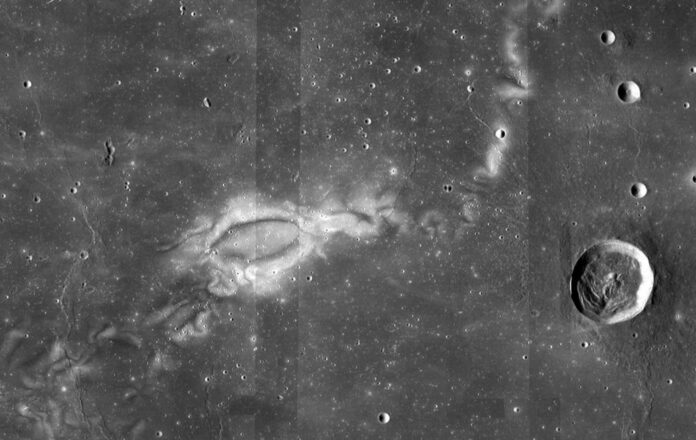
The Enigmatic ‘Lunar Swirls’ Explained
The curious ‘lunar swirls’ could be rocks magnetized by underground magma activity, researchers suspect.
Lunar swirls are light-colored, swirling patterns visible on the moon’s surface. They are notably bright, allowing even amateur astronomers to observe them. These mysterious phenomena have been challenging to explain for a long time. However, new models and spacecraft data now offer more insight into this ancient mystery.
Lunar Swirls
Lunar swirls have sparked considerable discussion. Some believe the swirls resemble brushstrokes in an abstract painting, while others compare them to misty clouds on the moon’s dark surface. What we do know is that they are vast: NASA images show that the ‘tentacles’ of some lunar swirls extend over hundreds of kilometers. The most well-known lunar swirl is Reiner Gamma.
Origin
Currently, researchers do not fully understand how these mysterious ‘swirls’ on the moon originate. However, they eagerly seek to learn more. Discovering the origin of lunar swirls is seen as crucial for understanding the processes that shaped the moon’s surface. It can also provide more insight into the moon’s magnetic history and inform us about how planetary and lunar surfaces interact with the space environment.
Magnetic Rocks
Most swirls are accompanied by strong magnetic fields. Data suggests that the rocks within the swirls are magnetized, causing them to deflect or reroute particles from the solar wind constantly bombarding the moon. As a result, nearby rocks get the full impact. Over time, these neighboring rocks darken due to chemical reactions from the collisions, while the swirls remain light in color.
How?
A pressing question remains: how are the rocks in lunar swirls magnetized? Since the moon currently lacks a magnetic field, this is a major mystery. Moreover, no astronaut or rover has visited a lunar swirl to investigate this phenomenon directly. “Impacts could lead to such magnetic anomalies,” suggests researcher Michael Krawczynski. He notes that meteorites regularly deliver iron-containing material to various parts of the moon’s surface. “But for some lunar swirls, it remains unclear how an impact could precisely cause such specific forms and sizes,” he says.
Alternative Theory
Krawczynski believes it is more likely that something else locally magnetized the swirls. “An alternative theory suggests that underground lava slowly cooling in a magnetic field could cause the magnetic anomalies observed in the swirls,” he explains. To test this, he and his colleagues conducted experiments. In these experiments, they measured the effects of different combinations of atmospheric chemistry and cooling rates of magma on a titanium-iron oxide mineral called ilmenite, which is abundant on the moon. They wanted to see if these conditions could produce a magnetizing effect.
Ilmenite
Using a model of magma cooling rates, Krawczynski and his team investigated how ilmenite could generate a magnetic effect. Their experiments show that under the right conditions, during the slow cooling in the moon’s crust and upper mantle, ilmenite grains can form iron and iron-nickel alloys that generate a powerful magnetic field. “The smaller grains we studied produced stronger magnetic fields because they have a larger surface area relative to their volume compared to the larger grains,” notes researcher Yuanyuan Liang. “This increased surface area makes it easier for the smaller grains to undergo the reduction reaction.”
Underground Magma
According to researchers, this effect could explain why there are strong magnetic areas at lunar swirls. “Our experiments showed that under similar conditions to those on the moon, we could produce the magnetizable material we expected,” says Krawczynski. “Therefore, it is plausible that these swirls are caused by underground magma.” However, one thing is essential. “If you want to create magnetic anomalies using the methods we investigated, the underground magma must have a high titanium content,” Krawczynski explains. “We have seen evidence of this reaction creating iron metal in lunar meteorites and Apollo mission samples. These samples, however, come from surface lava flows, while our research suggests that underground cooling significantly enhances these metal-forming reactions.”
Plausible Explanation
All in all, the study by Krawczynski and Liang offers a plausible explanation for the mystery of lunar swirls. By experimentally demonstrating that underground magma with a high titanium content can lead to the magnetization of ilmenite-rich rocks under lunar conditions, it is suggested that these magnetic anomalies arise from underground cooling lava.
Mystery Unraveled
This means that the mystery of lunar swirls is finally unraveled. Or is it? For now, experiments are the only way to investigate how invisible lava might cause the magnetic effects of the enigmatic lunar swirls. Krawczynski would like to study the processes directly. “If we could simply drill, we could check if this reaction occurs,” he says. “That would be fantastic, but for now, it’s not feasible. We are currently limited to research from the surface.”
Future Exploration
The study paves the way for more. The findings will contribute to interpreting data gathered by future lunar missions, particularly those aimed at exploring magnetic anomalies on the moon’s surface. For instance, NASA plans to send a rover to Reiner Gamma in 2025. This means that in just a few years, we may have the evidence needed to truly solve this mystery once and for all.











